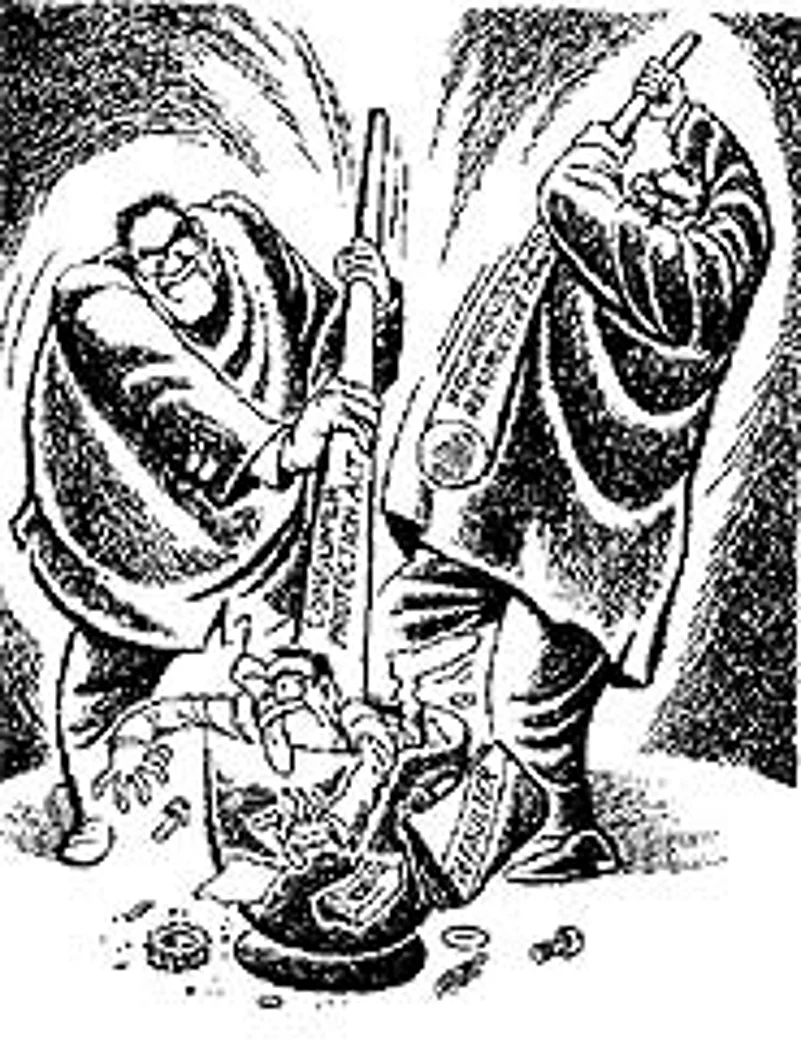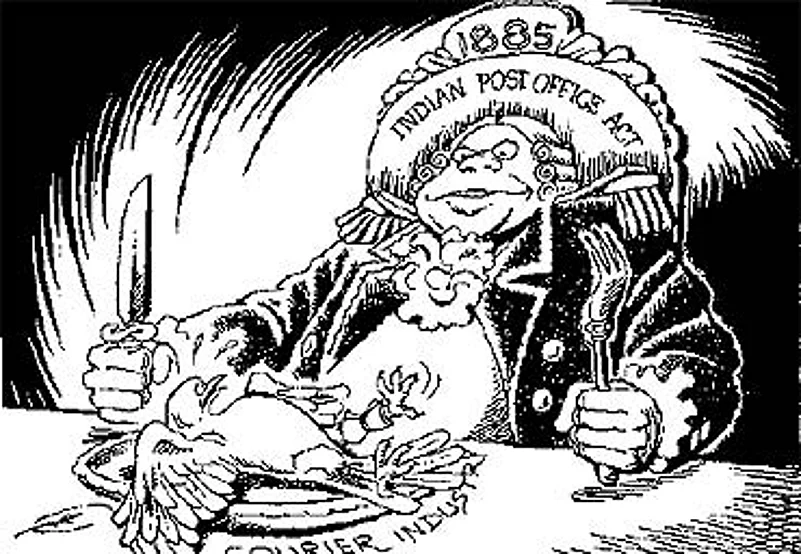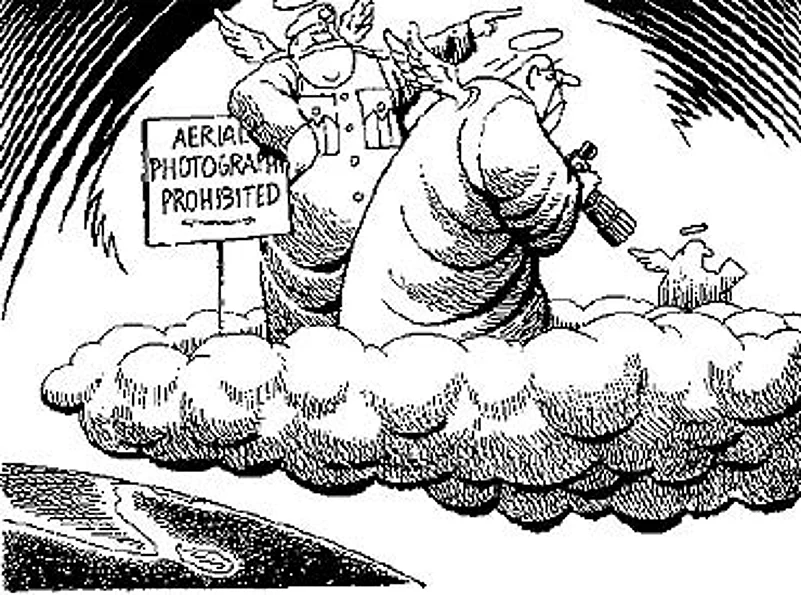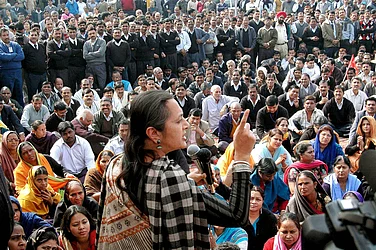Irrelevant, archaic, often nonsensical. Draconian and harmful. A time-consuming edifice that revels in red tape. That’s the Indian legal system in a nutshell. If that sounds too harsh, consider these statistics: about two-thirds of our laws have not been used in independent India. About 10 per cent of them can be scrapped right away. And most of the 40 per cent in use currently have so many obsolete and conflicting provisions that they serve far more as instruments of harassment than effective means of justice.
With good reason. The oldest law in the country has been in operation for over a century and half. The one-sentence 1836 Bengal District Act empowers the Bengal government to create as many zillas as it wants. The Act still exists. As do a host of others like the Indian Post Office Act of 1885, the Indian Evidence Act of 1850 or the Indian Serais Act of 1887. Most of them cater to a colonial and feudal socio-economic environment. And they exist side by side, mostly in complete disharmony, with the Acts passed by independent India, the Industrial Disputes Act of 1947, the Companies Act of 1956 and the Patents Act of 1970 (replacing the 1911 Act) and the Act last passed, the amended Copyright Act, 1994.
Under the Indian Serais Act, 1887, it is a punishable offence for "inn-keepers" not to offer free drinking water to passers-by. Recently, a Delhi five-star hotel was taken to court by the municipal corporation on the grounds that the hotel was not doing so. The real reason may have been that the hotel did not pay up the bribe demanded by a municipal inspector.
Dr Bibek Debroy, economist and coordinator of Project Large (a UN-funded programme looking into comprehensive legal reforms since 1993 and making recommendations to the Finance Ministry), says about five per cent of the areas technically under legal governance—credit cards, leasing and hire-purchase, electronic data transfer, ATMs—is ungoverned by any specific laws. The remaining 85 per cent is a badly mixed bag, with only a handful of laws updated and to the point.
A fact that’s borne out by the Law Commission, the advisory body on law-making. As part of its ongoing exercise of culling out the redundant laws and replacing them with ones more relevant to the present environment, the Commission has discovered that only about 40 per cent of our laws are in regular use. Independent India has till now found no conceivable use for the rest! The Commission is currently looking into the possibility of including such laws under a single codified system, says a member.
Unfortunately, the Law Commission has powers only to make suggestions to the Union Government. And it does so periodically, to change or scrap laws that have not been called into use for a long time, but in a very ad hoc manner, says Debroy. He suggests a provision built into the statute books for a law to be automatically scrapped after, say, 50 years if it has not been used even once. So far, the Law Commission has prepared 170 reports for posterity, including one suggesting scrapping of redundant laws, which have been clearly left on the shelf to gather dust. In fact, the staggering fact of the matter is that India does not have a law-making body, like the Federal Board of Law in the US.
The Indian Telegraph Act which was passed in 1885, when the concept of television obviously didn’t exist, has been invoked five times in the past three years by Doordarshan over telecast rights of cricket matches played in India. This very nearly derailed the telecast of the 1996 World Cup.
Hammurabi of Babylon, the world’s first real law-maker, had said that law is for society. So, the law will change as and when society changes; changes in society will not be determined by the law. In the past century and a half, the socio-economic framework of the country has undergone radical changes, but the legal structure has failed to keep pace with it.
C. Padmanabhan, legal expert on the IFCI board, says the confusion continues because legal reforms are low priority for parliamentarians. While India badly needs efficient laws, the time spent by the law-making body on the job is unbelievably little. Parliament spends less than 0.6 per cent of a Lok Sabha/Rajya Sabha day on law-making. There are 53 different bills pending now with Parliament—54, if Law Minister Ramakant Khalap’s promise to introduce the Judicial Reforms Bill in the current session is anything to go by. Unfortunately, some of these will have lapsed and will now have to be presented afresh by the new Lok Sabha.

Even today—years after hire-purchase, credit cards and ATMs have become part of our lives—there are no laws governing these transactions.
There are several reasons for a law becoming obsolete. It could be due to natural reasons—the passage of time, change of situation, over-exploitation of loopholes. The Police Act, 1861, still requires a policeman to take off his cap or helmet before a member of royalty. A ridiculous provision that nobody has thought of removing so far. According to Hemant and Sumant Batra, partners in law firm Kesar Dass B. & Associates, a law becomes automatically redundant after an amended and updated version comes into being. Since changing a law is such a lengthy and difficult process, a new law often comes to exist alongside the old one. For instance, the Indian Contracts Act and the Specific Relief Act, 1963, have overlapping areas, leaving enough room for confusion. A person sacked from a job may decide to sue his employer under the former, while the employer may take refuge under the latter. Section 108 of the Customs Act, Section 40 of FERA and Section 171A of the Sea Customs Act are identical, offering a wide choice to both trigger happy enforcement people and offenders looking for a loophole to slip through. Then there’s the Smugglers and Foreign Exchange Manipulators Act, 1976, a variant of COFEPOSA, whose sole objective is to forfeit illegally acquired properties of smugglers or forex manipulators and applies only to those convicted under the Sea Customs Act, 1878, or Customs Act, 1962, or FERA.
The second cause for obsolescence is historical. A large number of the provisions of the Foreign Exchange Regulations Act, 1973, are now out of tune with the present state of the Indian currency (see box). Or take the Indian Telegraphs Act, 1885, and the Indian Wireless Telegraph Act, 1933. Apart from being archaic to varying degrees, they also broadly overlap in jurisdiction and content. The word ‘telegraph’ embraces telephone and radio and gives the Centre exclusive rights to establish and conduct telegraph and telecom services and the right to licence private parties to establish the telegraph for their own or private use. Most of these provisions have become dated after the Telecom Policy of 1994 and Telecom Regulatory Authority of India Ordinance, 1996.
Section 138 of the Negotiable Instruments Act allows criminal proceedings against parties whose cheques have bounced. However, in January this year in Electronic Trade and Technology Development Corporation vs Indian Technologists and Engineers Pvt Ltd, the Supreme Court ruled that in cases where the issuer of the cheque has intimated the drawee by mail that he should not present the cheque, Section 138 does not apply. Banks and other lenders currently find their mailboxes swollen.
Then there are laws which are so detrimental to economic liberalisation that without a wide-ranging and comprehensive change programme, the entire reforms process may collapse. One of these is the Agricultural Land Ceiling Act, which permits nonresident Indians to invest in agriculture but does not permit absentee cultivation of holdings. By discouraging adoption of modern technology and scientific farming, the Act pressures the government to spend massive amounts to develop rural infrastructure. Similarly, the Urban Land Ceiling Act keeps land prices artificially high, skews the property market and discourages investment flows. Although domestic movement of agricultural goods is more or less free, the Essential Commodities Act, 1955, the Cotton Movement Control Order and Paddy Control Order, Milk and Milk Products Order and Agricultural Produce Regulated Market Act continue to exist, distorting the rural economy.

| A 1993 amendment to the Consumer Protection Act, 1986, added on the provisions of unfair trade practices, rendering the Monopolies and Restrictive Trade Practices Act totally redundant. But of course, the MRTP Act still exists. Also, under the CPA, judgement in every case has to be delivered within six months. |
Similarly, under the Industrial Disputes Act of 1947, an employer can’t effect any change in working conditions, wages, compensatory allowances, work hours, rest intervals, new disciplinary rules, even raise or reduce the number of workers (except casual) without permission from the appropriate authority. The complex industrial law regime, with over 50 major legislations and an equal number of state laws, include the Workmen’s Compensation Act of 1923, Trade Unions Act of 1926, Minimum Wages Act of 1936, Factories Act of 1948 and Industrial Disputes Act of 1947. Sections of this last Act make it difficult for employers to recast sick units through modernisation and technology upgradation and it restricts their right to make any change in service conditions while conciliation proceedings are on, thus encouraging trade unions to stall introduction of new technology.

If you courier a letter, you break the law. Because the Indian Post Office Act, 1885, reserves the "exclusive privilege of conveying letters" for the Government. Just call it a 'document' and it's legitimate.
There are even laws which go against constitutional provisions. For instance, one can prove that the economic reforms are actually against the Indian Constitution. Article 39 of the Directive Principles opposes policies that raise disparities in income and wealth. Therefore reforms, or for that matter, any policy statement, can be stayed on the ground that it’s widening the gulf between the rich and the poor. The Companies Act seemingly violates Section 139A of the Constitution, which says only the Supreme Court has the power to transfer cases. Section 446 of this Act gives overriding powers to a winding up court (over any high court or the Supreme Court). It states that when a court orders the winding up of a company or appointment of a liquidator, all cases pending against the company in any court would be automatically transferred to the winding up court without the requirement of Supreme Court approval.

It’s illegal to shoot pictures from an aircraft, hot-air balloon, even from bridges and dams on rivers, without permission from the Defence Ministry.
Some laws also infringe on the fundamental rights of citizens. Under Section 47 of the Hindu Marriage Act, a couple cannot get a divorce within one year of the marriage, even if one of the parties is found to be insane or a warranted criminal. Even in case of divorce by mutual consent, Section 13B allows a lock-in period of one year before the grant of a divorce. Section 377 of the Indian Penal Code says whoever voluntarily has carnal intercourse "against the order of nature" can be imprisoned for life and fined. Which means homosexuals and lesbians are outlawed. And oral sex is illegal. "A husband and wife having fellatio can be reported to the police," says a Bombay-based advocate. All this, by laying down a behaviour code, violates the privacy of citizens.
Under Section 437 of the Indian Penal Code, a guilty woman can be released on bail merely because she is a woman. On the other hand, Section 378 renders futile most attempts by rape victims to get the guilty booked.
By refusing to change with the times, these laws also bar the ordinary citizen’s access to justice or even right to normal behaviour. There’s no way a woman can prove she was raped. Under Section 378, a medical examination immediately after rape, to prove penetration and the existence of semen inside the raped person’s body, is the only instrument available to nail the guilty. And only rape is a jailable offence, not sexual molestation. The Lunacy Act takes a harmless epileptic to be the same as a certified lunatic. Poor, homeless persons are often harassed as the Vagrancy Act allows anyone who’s "loitering with intent" to be booked. (How do you prove that you had no "intent" as you loitered?) Thanks to a piece of ridiculous legislation called the Prevention of Seditious Meetings Act, 1911, an independent India can still disallow a prisoner from wearing a khadi Gandhi cap.
The Police (Incitement to Disaffection) Act, 1920, has been used just twice. Once against Lokmanya Tilak. The second time was in 1984—against the author of a pamphlet that commended the police for forming an association to demand better rights. (Striking textile mill workers had rioted and the cops had stayed away.)
There's a lot of repetitive legislation in India, thanks to the Concurrent List which allows laws to exist at the Central as well as the state level separately. Take, for instance, the Indian Stamp Act or the General Court Fees Act, of which every state has individual versions. Each state also has its own civil procedure code apart from the Central code. The provisions of the Indian Electricity Act, 1910, Electricity (Supply Act), 1948, and the Indian Electricity Rules, 1956, prevent Central intervention at the state level, while also discouraging foreign/private investment. A new Act merging the three needs to be promulgated urgently.
Even after a law sees the light of day, it may remain on paper due to lack of clarity in applicability. The Hire-Purchase Act of 1972, for instance, never metamorphosed into an Act. For a Bill to become an Act, it must be passed by both Houses of Parliament, but this was passed by only one House. Due to lack of interest in the Bill, it just lapsed. This has resulted in a piquant situation: buyers of vehicles on hire-purchase/bank loans can’t be prosecuted by the financier nor the vehicle repossessed even if they default on repayment, because there’s no law for it. In such cases, the only recourse open to the financier is to send thugs to the defaulter. However, a wily defaulter can run rings round the lender by lodging dacoity cases against the lender, and claiming that he had a large amount of money lying in the car when it was seized.
Clearly, legal reforms are a gigantic task and few have gone into its logistics. Debroy feels it has to be a continuous process, as it is in the rest of the world. The idea should be to retain the purpose of the law while shearing off non-operational aspects. But legal experts are not unanimous on the future of obsolete laws. Obsolescence, they argue, is a relative concept, and what is redundant for one may be extremely relevant for another. For instance, a group of people in southern Bihar want a law for the prosecution of witches. Women accused of being witches and getting persecuted is a common problem in the rural areas of Bihar, Bengal, Orissa and Madhya Pradesh, but an absurdity for most urbanites.
Rajeev Dhavan, Supreme Court lawyer, says identifying deadwood might prove futile as, juristically, India does not have a concept of ‘desitude’ under which such an exercise can be undertaken. No legal revision can be done in the abstract; the relevance of some laws would appear only on use. "The question of obsolescence is not simply a question of mechanical exition, but requires thoughtful consideration," he adds.

Under Section 29-A of the Representation of the Peoples Act, you can’t register a political party that doesn’t abide by the "principles of socialism".
He recalls that several unsuccessful attempts were made between 1937 and 1952, through special reform commissions, to change British laws, on which most Indian laws are based. The task of codifying the British law structure ultimately became an exercise in the wilderness. In India too, sporadic attempts at legal reforms have come to nought. Dhavan says that as liberalisation has heightened the need for changes in law, an increase in the pace of one might rub off on the other. But that’s a chicken-and-egg question—in many cases, as in privatisation of infrastructure like power, ports and highways, the process of liberalisation appears to have reached a dead-end in obsolete and unsupportive laws.
Debroy feels that the scrapping of the concurrent list will cut down on a number of areas where state legislations, often a carbon copy of the Central Act, exist only to confuse matters. It will also clearly demarcate areas for state governance and lay down uniform rules in the rest for all states to follow without question. For instance, the state of Rajasthan has always opposed provisions of the Narcotics, Drugs and Psychotropic Substances Act, as many of its communities ritually smoke marijuana at wedding ceremonies. To skirt the long bottlenecks encountered in changing a law, most states are now recoursing to issuing circulars and orders in haste, many of which often turn out to be ineffective and unconstitutional. Unknown to most denizens of the state, Maharashtra, for instance, is technically ‘dry’, with liquor available only to people who hold permits on medical grounds.
In some sort of a futile face-saving exercise, bars in the state are still called ‘permit rooms’.
Lack of political will is only part of the reason. The red tape involved in changing a law presents a more horrific nightmare. The Legal Aid Bill of 1987 came into effect only after amendment in end-1995. Says Amit Mitra, secretary general of FICCI: "To introduce the three words ‘private sector participation’ in the Indian Telegraph Act, it took the Finance Ministry more than 80 pages of rules and procedures and over three years, during which time the file kept shuttling between the Finance and Communication Ministries several times over. " If any state seeks an alteration in a Central Act, the proposal will spend most of its (predictably long) life in transit between all the departments concerned. If it so happens that the initiator is an Opposition-ruled state, its woes can only increase. The only way for it to present the bill is through its own member in Parliament, where it’s most often voted out. As only the ruling party can car ry through any change (a bill has to be passed by a simple majority in both the Houses), amendments or new laws take eons to see the light of day.
Vested interests, adds Dhavan, play an equally important role. The beneficiaries of the existing law are the biggest votaries for status quo. Secondly, making innovative and controversial legislation which steps on many toes requires a far greater degree of consensus. Take the Rent Control Act, which not only discourages private investment in real estate by disallowing market fixation of rent, it forbids landlords from evicting or taking any step against defaulting tenants. But the modified Delhi Rent Act, 1995, based on the model Central Act has been termed pro-landlord and evoked strong protests.
Under Section 8 and 9 of FERA, one is not allowed to hold foreign coin collections worth over $500. Even this is a revised limit: before July 17, 1992, the figure was $200. This amendment came after a widely publicised lawsuit involving a private citizen who had to finally pay a nom -inal fine of Rs 2,000.

Under the Aircraft Act, 1934, the Government can control "manufacture, possession, use, sale of aircraft". And ‘aircraft’ includes balloons and kites.
Often, it’s not so much the statute books which are guilty as are the procedures. Out of the three procedure codes in India, the Indian Evidence Act was passed in 1850 and the Criminal Procedure Code (CrPC) and the Civil Procedure Code (CPC) were passed early this century. Honorifics like outdated, lengthy, complex come easily to mind. The main problem, however, is that they are completely silent on the maximum number of days by which a case must be settled. This ensures that cases drag on interminably, while alleged offenders waste away behind bars. With few courts and that too bursting at the seams with pending litigation, a person arrested under the CrPC may actually spend his full term in jail just waiting for trial even before he’s proved guilty. In 1992, the Supreme Court had a backlog of 1.5 lakh cases. And the lower courts have a backlog of around 20 million. Needless to say, such a system of justice distribution is loaded highly against the poor and the weak. Says Batra: "The CPC can be cut down to about 10 pages, without any harm to the process of justice."
The poor conviction rates also substantiate the role of procedures in serving more as instruments of harassment than proving the effectiveness of law. Delhi Police, for instance, has a conviction rate of 11 per cent. Prosecutions for FERA violation, which account for most of the economic crimes, lead to only 2 per cent convictions. And Mumbai commissioners admit to only 118 convicted so far under COFEPOSA, a draconian piece of legislation passed 23 years ago. What’s worse, says Padmanabhan, is that unlike other countries, India doesn’t have the practice of pre-trial consultations and conferences which can help fast settlement and weed out many cases before they reach court. The entire procedure is done in court, thereby stretching litigation time.
The time has come for the politician to propose and the bureaucrat to follow, says Amit Mitra. Unfortunately, the present political state doesn’t quite ensure that. The new-found judicial activism needs strong support from individual lobbies and the media to be sustained. Take the electoral reforms bills, which started their journey towards Parliament in 1972, but are yet to metamorphose into an Act. The last Lok Sabha didn’t manage to pass any bill since 1995; the new one has not yet transacted any legal business. A CII taskforce on judicial reforms has submitted its report to the Government. Debroy’s Project Large has in the last three years submitted 23 reports on reforms in FERA, consumer protection, environment, labour laws, etc, to the Finance Ministry. And that’s where things got stuck. Sans a proper lawmaking body, individual law-making initiatives by members of Parliament remain the rather slender ray of hope against centuries of dust. But who’ll bill the cat?






















